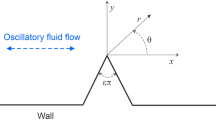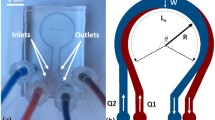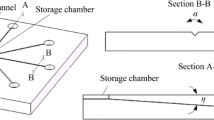Abstract
The traversal rate for the liquid medium near a microfluidic channel edge is faster than that through the body of the channel, which makes the fluid front becomes concave rather than convex or flat. The concave front is unwished due to its influences on quantitative analysis accuracy and the possibility to generate air bubbles which will do harm to analysis process. Here, a method which can control the shape of fluid front in a microfluidic channel is presented. The channel edges that are parallel to the direction of flow are designed to three types of serrated shapes, including semicircle, triangle and trapezoid. The effects of their length ratio (r), peak distance (w) and phase mode (p) on meniscus curvature and flowing speed have been studied. Results have shown that the channel with serrated edges can generate convex fluid front, and the curvature of the fluid front as well as the flowing speed can be changed by adjusting r, w and p.







Similar content being viewed by others
References
Ahmadlouydarab M, Azaiez J, Chen Z (2015) Dynamics of viscous liquid bridges inside microchannels subject to external oscillatory flow. Phys Rev E 91:023002
Chen G, Xu XY, Lin YH, Wang J (2007) A sol–gel-modified poly(methyl methacrylate) electrophoresis microchip with a hydrophilic channel wall. Chem Eur J 13:6461–6467
Chin CD, Linder V, Sia SK (2012) Commercialization of microfluidic point-of-care diagnostic devices. Lab Chip 12:2118–2134
Choi M, Na Y, Kim SJ (2015) Hydrophilic strips for preventing air bubble formation in a microfluidic chamber. Electrophoresis 36:2896–2901
Concus P, Finn R (1969) On behavior of a capillary surface in a wedge. Appl Math Sci 63:292–299
Fatona A, Chen Y, Reid M, Brook MA et al (2015) One-step in-mould modification of PDMS surfaces and its application in the fabrication of self-driven microfluidic channels. Lab Chip 15:4322–4330
Gitlin L, Schulze P, Ohla S, Bongard HJ et al (2015) Surface modification of PDMS microfluidic devices by controlled sulfuric acid treatment and the application in chip electrophoresis. Electrophoresis 36:449–456
Habouti S, Kunstmann-Olsen C, Hoyland JD, Rubahn HG et al (2014) In situ ZnO–PVA nanocomposite coated microfluidic chips for biosensing. Appl Phys A 115:645–649
Huang PH, Xie YL, Ahmed D, Rufo J (2013) An acoustofluidic micromixer based on oscillating sidewall sharp-edges. Lab Chip 13:3847–3852
Hyung JK, Woong KJ, Byeong HK, Young HS (2016) Advancing liquid front shape control in capillary filling of microchannel via arrangement of microposts for microfluidic biomedical sensors. Int J Precis Eng Manuf 17:59–63
Jung W, Han J, Choi JW, Ahn CH (2015) Point-of-care testing (POCT) diagnostic systems using microfluidic lab-on-a-chip technologies. Microelectron Eng 132:46–57
Kang JH, Kimab YC, Park JK (2008) Analysis of pressure-driven air bubble elimination in a microfluidic device. Lab Chip 8:176–178
Lee GB, Lin CH, Lee KH, Lin YF (2005) On the surface modification of microchannels for microcapillary electrophoresis chip. Electrophoresis 26:4616–4624
Luppa PB, Müller C, Schlichtiger A, Schlebusch H (2011) Point-of-care testing (POCT): current techniques and future perspectives. Trends Anal Chem 30:887–898
Majid A, Zhong-Sheng L, James JF (2011) Interfacial flows in corrugated microchannels: flow regimes, transitions and hysteresis. Int J Multiph Flow 37:1266–1276
Nakayama T, Kurosawa Y, Furui S, Kerman K et al (2006) Circumventing air bubbles in microfluidic systems and quantitative continuous-flow PCR applications. Anal Bioanal Chem 386:1327–1333
Sista R, Hua Z, Thwar P, Sudarsan A et al (2008) Development of a digital microfluidic platform for point of care testing. Lab Chip 8:2091–2104
Skelley AM, Voldman J (2008) An active bubble trap and debubbler for microfluidic systems. Lab Chip 8:1733–1737
Sung JH, Shuler ML (2009) Prevention of air bubble formation in a microfluidic perfusion cell culture system using a microscale bubble trap. Biomed Microdevices 11:731–738
Truong DS (2013) In: Kwang WH, Hyun CB, Young HS, Byeong HK (eds), Analysis of liquid meniscus shape in various microchannels for biomedical diagnostic device. 4th International Conference on Biomedical Engineering in Vietnam, pp 145–148
Weislogel MM, Lichter S (1998) Capillary flow in an interior corner. J Fluid Mech 373:349–378
Wu W, Kang KT, Lee NY (2011) Bubble-free on-chip continuous-flow polymerase chain reaction: concept and application. Analyst 136:2287–2293
Zhao YJ, Cho SK (2007) Micro air bubble manipulation by electrowetting on dielectric (EWOD): transporting, splitting, merging and eliminating of bubbles. Lab Chip 7:273–280
Zhou JW, Ellis AV, Voelcker NH (2010) Recent developments in PDMS surface modification for microfluidic devices. Electrophoresis 31:2–16
Zimmermann M, Schmid H, Hunziker P (2006) Delamarche Emmanuel. Capillary pumps for autonomous capillary systems Lab Chip 7:119–125
Zimmermann M, Hunziker P, Delamarche E (2008) Valves for autonomous capillary systems. Microfluid Nanofluid 5:395–402
Acknowledgements
This work was supported by the National Natural Science Foundation of China (51375076, 51475079), Science Fund for Creative Research Groups of NSFC (51621064) and the National Key Technology R&D Program (2015BAI03B08). This work was also supported by Fundamental Research Funds for the Central Universities (DUT15LAB12).
Author information
Authors and Affiliations
Corresponding author
Rights and permissions
About this article
Cite this article
Li, J., Liang, C., Wang, S. et al. Using serrated edges to control fluid front motion in microfluidic devices. Microsyst Technol 23, 4733–4740 (2017). https://doi.org/10.1007/s00542-017-3306-z
Received:
Accepted:
Published:
Issue Date:
DOI: https://doi.org/10.1007/s00542-017-3306-z




